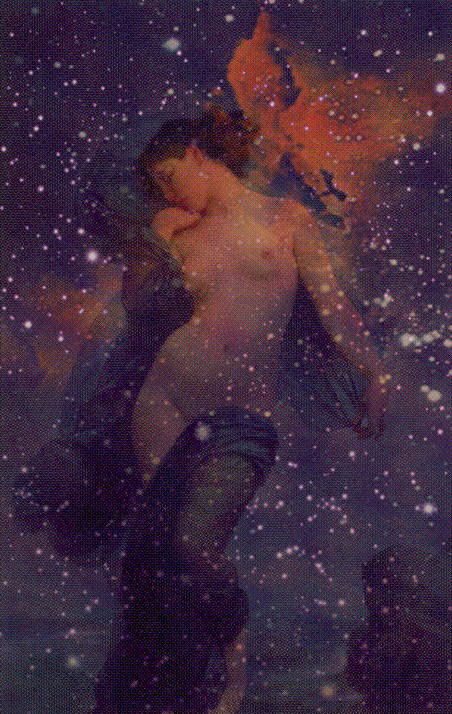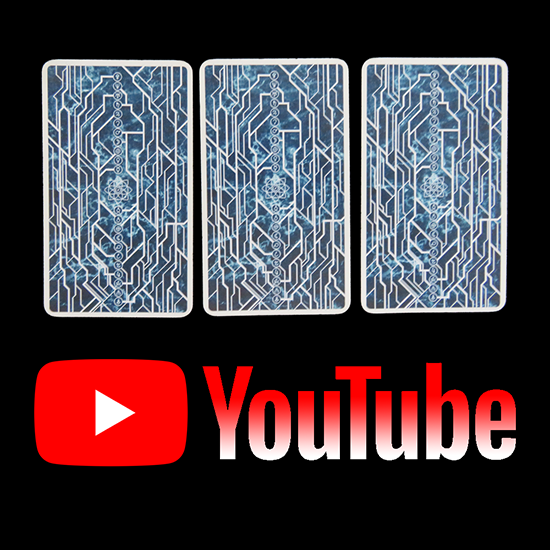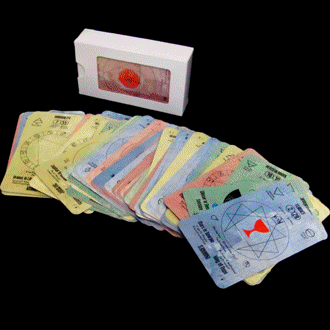When I first opened the plastic box of this deck and book set, I was strongly reminded of many of the decks published in the mid-eighties, very “cosmic” and alternative. So I was quite surprised this is actually a deck published in 2001.
The art is very intuitive and I find it is very typical for a Pisces artist – the dreamy and emotional style, the use of effects like starry nebulas, fading and dissolving motives, spheres and ethereal figures. Most cards show soft, matted colors and a color scheme with many hues of blue, but some are vibrant and therefore spring out at you in a layout (e.g. the Magician, the Emperor, Justice (which is 8) and the Devil). The backs are reversible. While Pilz has developed his own symbolism, most of the meanings fit well into the traditional categories and may even bring out some new aspects of a well-known card.
Some of the Majors are renamed: The Chariot is the Charioteer, the Hanged Man is Reversal, Temperance is Equalization, and Judgement is Change of Times.
My favorite card interpretations include the Fool , the Charioteer and Death. The Fool is levitating in a playful position between clouds, using the earth globe as a ball. Pilz says that while the Fool is traditionally depicted at the border of an abyss, he is actually already one step further: for him, laws and borders are simply nonexistent. The Charioteer is portrayed as the statue of an Eastern deity, sitting calm and in concentration on a pedestal while two white mares in full gallop run on either side. I like the idea of how much inner balance is required to achieve the outer balance of opposing forces. Death shows transparent images of a skull, a clock, a dark red rose, a dove and a letter in Hebrew fading into each other. The whole card has a somewhat nostalgic feeling about it, which reminds me why this card is scary for many – we cling to our old, comfortable memories, yet we know a single lifespan is limited.
Other cards are less obvious to me. For example, the Empress is a transparent, ghost-like figure melting into the starry sky, behind some grass and ferns. The Empress to me is one of the more touchable cards, with earth and water, but hardly airy qualities. Indeed, Pilz himself connects her with Moon, Venus, and Taurus. Still, it is a very beautiful image of a strong female presence.
The Minors are pips. Suits are Swords, Flames, Cups and Spheres. Court cards are King, Queen, Knight and Princess.
Some of the court cards seem to depict celebrities. The Knight of Flames is the late singer of the Doors, Jim Morrison. The same familiar female face stars as the Queen of Swords, the Knight of Swords, and the Magician. The Knight of Cups is Christ, His face floating in the sky above a glass of wine and a loaf of bread, probably a symbol for the Last Supper. The card is meant to show a “spiritual warrior”. They are traditionally interpreted as characters, who might be significant regarding the querent’s situation.
The pips show the appropriate number of suit symbols, though they are not necessarily identical. The Swords suit is the least imaginative, showing swords flying through dreamlike landscapes. Cups are sometimes long-stemmed wine glasses, sometimes silver chalices. Spheres, to show their relation to the material world, show often not only landscapes, but also buildings and other architectural structures. The suit of Flames doesn’t show flames, but all sorts of rays, stars, and rainbows. They are very beautiful pips, but still pips!
All cards are assigned several astrological correspondences (see chart for the Major Arcana below), which include not only the relationships to planets, elements and signs, but also takes the aspects into account (Minor Arcana).
Review by Morwenna Morasch at tarotpassages.com
















